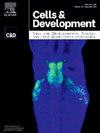Equine adult, fetal and ESC-tenocytes have differential migratory, proliferative and gene expression responses to factors upregulated in the injured tendon
IF 3.9
4区 生物学
Q4 Biochemistry, Genetics and Molecular Biology
引用次数: 0
Abstract
Tendon injuries are a common problem in humans and horses. There is a high re-injury rate in both species due to the poor regeneration of adult tendon and the resulting formation of scar tissue. In contrast, fetal tendon injuries undergo scarless regeneration, but the mechanisms which underpin this are poorly defined. It is also unclear if tendon cells derived from embryonic stem cells (ESCs) would aid tendon regeneration. In this study we determined the responses of adult, fetal and ESC-derived equine tenocytes to a range of cytokines, chemokines and growth factors that are upregulated following a tendon injury using both 2-dimensional (2D) and 3-dimensional (3D) in vitro wound models.
We demonstrated that in 2D proliferation assays, the responses of fetal and adult tenocytes to the factors tested are more similar to each other than to ESC-tenocytes. However, in 2D migration assays, fetal tenocytes have similarities to both adult and ESC-tenocytes. In 3D wound closure assays the response of fetal tenocytes also appears to be intermediary between adult and ESC-tenocytes. We further demonstrated that while TGFβ3 increases 3D gel contraction and wound healing by adult and fetal tenocytes, FGF2 results in a significant inhibition by adult cells.
In conclusion, our findings suggest that differential cellular responses to the factors upregulated following a tendon injury may be involved in determining if tendon repair or regeneration subsequently occurs. Understanding the mechanisms behind these responses is required to inform the development of cell-based therapies to improve tendon regeneration.

马成年、胎儿和esc -腱细胞对损伤肌腱中上调的因子有不同的迁移、增殖和基因表达反应
肌腱损伤是人类和马的常见问题。由于成体肌腱再生能力差和瘢痕组织的形成,这两种动物的再损伤率都很高。相比之下,胎儿肌腱损伤经历无疤痕再生,但其机制尚不明确。来自胚胎干细胞(ESCs)的肌腱细胞是否有助于肌腱再生还不清楚。在这项研究中,我们使用二维(2D)和三维(3D)体外伤口模型确定了成人、胎儿和esc来源的马肌腱细胞对一系列细胞因子、趋化因子和生长因子的反应,这些细胞因子在肌腱损伤后上调。我们证明,在2D增殖试验中,胎儿和成人的细胞对这些因子的反应比对esc细胞的反应更相似。然而,在二维迁移实验中,胎儿细胞与成人细胞和esc细胞有相似之处。在3D伤口闭合实验中,胎儿细胞的反应似乎也介于成人和内皮细胞干细胞之间。我们进一步证明,tgf - β3增加了成人和胎儿细胞的3D凝胶收缩和伤口愈合,而FGF2对成人细胞有显著的抑制作用。总之,我们的研究结果表明,肌腱损伤后细胞对上调因子的差异反应可能与肌腱修复或再生是否随后发生有关。了解这些反应背后的机制是为开发基于细胞的治疗方法来改善肌腱再生提供信息的必要条件。
本文章由计算机程序翻译,如有差异,请以英文原文为准。
求助全文
约1分钟内获得全文
求助全文
来源期刊

Cells and Development
Biochemistry, Genetics and Molecular Biology-Developmental Biology
CiteScore
2.90
自引率
0.00%
发文量
33
审稿时长
41 days
 求助内容:
求助内容: 应助结果提醒方式:
应助结果提醒方式:


